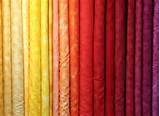These Innovative Textile Technologies Could Be Lifesaving

Last year, researchers at the Ian Potter NanoBioSensing Facility and NanoBiotechnology Research Lab in Melbourne, Australia were experimenting with a new technology that could be used to design clothes, blankets, carpets and other textiles capable of cleaning themselves. Here’s what they found: copper and silver-based nanostructures grown directly onto different textiles release “hot electrons” when exposed to light, giving them a “burst of energy” that allows them to break down organic matter.
Reducing the need for washing is nice enough on it’s own, but even better? Researchers have said the technology could also be used to develop antibacterial textiles, designed to fight and kill superbugs and help keep people infection-free. And they don’t seem to be far off.
Scientists from the University of Leeds have created a new product made from a material that can disinfect itself. Surfaceskins replaceable door pushpads are designed to kill germs by secreting a small amount of alcohol-gel with every touch. Fitted into a plastic holster, these unique pads can be easily installed on any doorway, reducing bacteria levels by over 90%. It’s a great solution for places like hospitals, where infections are common. According to the Centers for Disease Control, there are roughly 1.7 million hospital acquired infections each year, though the product could also be used in offices, schools and many other settings.
The Surfaceskins website notes that, “Hand hygiene compliance by healthcare workers has been shown to be less than 30% in some instances,” and, “Numerous studies have identified door handles and push plates as prime sources of microbial contamination…Surfaceskins have been developed in collaboration with key international infection control experts and material scientists to specifically help reduce the transmission of germs from repeated door contact…Surfaceskins kills germs in seconds.”
Global Market Insights, Inc. predicts that the smart and interactive textiles market will reach beyond $6.5 billion in the next decade, with self-cleaning and antimicrobial textiles becoming more widely developed. The implications of such products seem endless, and it’s not unlikely that we’ll see more of these textiles used in the medical, transportation, military and retail industries over the next few years. To learn more, click here.
